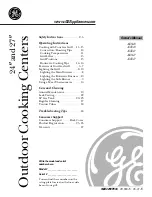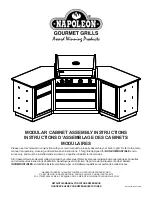
2
WARNING: SOME DUST CREATED BY POWER SANDING, SAWING,
GRINDING, DRILLING, AND OTHER CONSTRUCTION ACTIVITIES
contains chemicals known to cause cancer, birth defects or other
reproductive harm. Some examples of these chemicals are:
· lead from lead-based paints,
· crystalline silica from bricks and cement and other masonry products, and
· arsenic and chromium from chemically-treated lumber.
Your risk from these exposures varies, depending on how often you do this
type of work. To reduce your exposure to these chemicals: work in a well
ventilated area, and work with approved safety equipment, such as those dust
masks that are specially designed to filter out microscopic particles.
GENERAL SAFETY RULES
FOR ALL BATTERY OPERATED TOOLS
WARNING: READ AND UNDERSTAND ALL INSTRUCTIONS.
Failure to follow all instructions listed below, may result in electric shock, fire
and/or serious personal injury.
SAVE THESE INSTRUCTIONS.
WORK AREA
1.
Keep your work area clean and well lit.
Cluttered benches and dark
areas invite accidents.
2.
Do not operate power tools in explosive atmospheres, such as in the
presence of flammable liquids, gases, or dust.
Power tools create sparks
which may ignite the dust or fumes.
3.
Keep bystanders, children, and visitors away while operating a
power tool.
Distractions can cause you to lose control.
ELECTRICAL SAFETY
1. Do not abuse the cord. Never use the cord to carry the tool. Keep
cord away from heat, oil, sharp edges or moving parts. Replace damaged
cords immediately.
Damaged cords may create a fire.
2.
A battery operated tool with integral batteries or a separate battery
pack must be recharged only with the specified charger for the battery.
A charger that may be suitable for one type of battery may create a risk of fire
when used with another battery.
3.
Use battery operated tool only with specifically designated battery
pack.
Use of any other batteries may create a risk of fire.
PERSONAL SAFETY
1.
Stay alert, watch what you are doing, and use common sense when
operating a power tool. Do not use tool while tired or under the influence
of drugs, alcohol, or medication.
A moment of inattention while operating
power tools may result in serious personal injury.
2.
Dress properly. Do not wear loose clothing or jewelry. Contain long
hair. Keep your hair, clothing, and gloves away from moving parts.
Loose
clothes, jewelry, or long hair can be caught in moving parts.
3.
Avoid accidental starting. Be sure switch is in the locked or off
position before inserting battery pack.
Carrying tools with your finger on the
switch or inserting the battery pack into a tool with the switch on invites
accidents.
4.
Remove adjusting keys or wrenches before turning the tool on.
A
wrench or a key that is left attached to a rotating part of the tool may result in
personal injury.
5.
Do not overreach. Keep proper footing and balance at all times.
Proper footing and balance enables better control of the tool in unexpected
situations.
906992 - 08-10-02.qxd 8/9/02 4:07 PM Page 2































